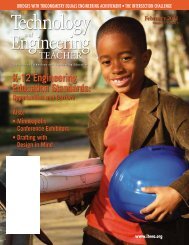March - Vol 70, No 6 - International Technology and Engineering ...
March - Vol 70, No 6 - International Technology and Engineering ...
March - Vol 70, No 6 - International Technology and Engineering ...
Create successful ePaper yourself
Turn your PDF publications into a flip-book with our unique Google optimized e-Paper software.
If there is a high amount of DNA methylation, it would<br />
be associated with a higher risk of cancer (Johns Hopkins<br />
University, 2009).<br />
Other endeavors to incorporate the benefits of<br />
nanotechnology into the medical world include the<br />
theory of the development of the microbivore or medical<br />
nanorobot: “a machine the size of a bacterium, comprising<br />
many thous<strong>and</strong>s of molecule-sized mechanical parts<br />
(resembling gears, bearings, <strong>and</strong> ratchets), possibly<br />
composed of a strong diamondlike material” (Freitas,<br />
2009, p. 1). Freitas (2009) further describes the appearance<br />
of the nanorobot. It will require motors to run, arms to<br />
manipulate, <strong>and</strong> legs for mobility. It will also require a<br />
power supply, guidance sensors, <strong>and</strong> an onboard computer<br />
to control behavior. This nanorobot must be small<br />
enough to travel through the blood stream or the smallest<br />
capillaries in the human body. Freitas (2009) also predicts<br />
that, with diligent effort, such a nanorobot could be in<br />
existence <strong>and</strong> operable by the 2020s.<br />
The purpose of these nanorobots could vary. For example,<br />
one medical nanorobot might be used in the form of a<br />
white blood cell. Its objective would be to seek out any<br />
undesirable pathogens such as bacteria, viruses, or fungi<br />
in the bloodstream. A patient could be injected with<br />
about 100 billion microbivores. They would hunt for the<br />
Photo 3: Medical applications of nanotechnology include<br />
incredibly small robots called microbivore. This illustration<br />
shows a microbivore, which would be made of many molecularsized<br />
parts such as a power supply, motors, arms, <strong>and</strong> legs to<br />
move about <strong>and</strong> complete its tasks. Credit: © 2001 Zyvex Corp.<br />
<strong>and</strong> Robert A. Freitas Jr. (design), additional design Forrest<br />
Bishop. All Rights Reserved<br />
different bacteria <strong>and</strong> consume them into amino acids. The<br />
nanorobot would then harmlessly eliminate the amino acids<br />
through an exhaust port (Freitas, 2009).<br />
Freitas (2009) explains the enormous potential for such<br />
nanorobots. Instead of subjecting the entire body to a<br />
drug whose purpose is to eradicate a single bacteria while<br />
at the same time increasing the potential for several<br />
unwanted side effects, creating a nanorobot whose job is<br />
to seek <strong>and</strong> devour the unwanted pathogen without the<br />
use of drugs could be done. The potential these robots<br />
could offer is incredible. For example, patients would be<br />
monitored by doctors continuously through the robots’<br />
onboard computers resulting in benefits such as: virtual<br />
instant blood work results, early detection of disease, <strong>and</strong><br />
monitoring of slowly developing chronic diseases.<br />
Nanotechnology has been applied to biomimicry as well.<br />
Biomimicry (derived from bio, which means life, <strong>and</strong><br />
mimesis, which means to imitate) is a new science <strong>and</strong> an<br />
art created to emulate nature’s biological development to<br />
solve human problems (Biomimicry Institute, 2007). The<br />
Biomimicry Guild has developed a Biology Design Spiral. It<br />
is used as a tool that guides an innovator through the design<br />
process to create a more sustainable design. The first step is<br />
to identify the real problem to be solved by writing a design<br />
brief. Second, the innovator must interpret the design brief<br />
to determine the specific function from nature for which<br />
they are looking. Next, they must discover models in nature<br />
that accomplish the same task successfully. Once the initial<br />
phases of identifying the problem have been completed,<br />
the designer must work through the abstract phase where<br />
they seek to find repeating patterns that achieve the success<br />
desired. Next, the designer would seek to emulate the same<br />
processes that nature uses, <strong>and</strong> finally, they would evaluate<br />
their results (Biomimicry Institute, 2007).<br />
Using the biomimicry method, The University of Michigan<br />
has developed a layered plastic based on the brick-<strong>and</strong>mortar<br />
molecular structure of a seashell (Biomimicry <strong>and</strong><br />
Nanotechnology, 2007). Kotov describes the synthetic<br />
material, which is stronger than plastic but lighter <strong>and</strong> more<br />
transparent, as nearly “a plastic steel” (Biomimicry <strong>and</strong><br />
Nanotecnology, 2007, p. 1). The potentials for this plastic<br />
could lend to lighter, stronger armor for military personnel<br />
<strong>and</strong> police officers as well as their vehicles. There could<br />
also be applications “in microelectromechanical devices,<br />
microfluidics, biomedical sensors <strong>and</strong> valves, <strong>and</strong> unmanned<br />
aircraft” (Biomimcry <strong>and</strong> Nanotechnology, 2007, p. 1).<br />
Kotov (2007) <strong>and</strong> his associates describe how they were<br />
able to solve a significant problem that has baffled scientists<br />
14 • <strong>Technology</strong> <strong>and</strong> <strong>Engineering</strong> Teacher • <strong>March</strong> 2011
















